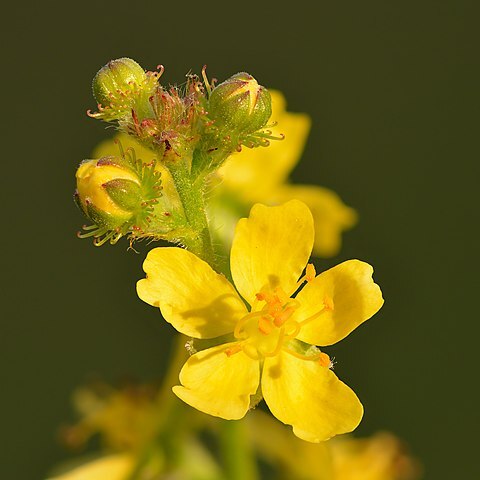Hypanthium obconic to hemispheric, armed above with hooked bristles, becoming indurate and 10-grooved at maturity; sep spreading at anthesis, later incurved at base and connivent above, forming a beak on the fr; pet 5, yellow, small; stamens 5–15; ovaries 2, concealed within the hypanthium, ripening into achenes; style terminal; perennial herbs from stout rhizomes, the 3–many large lfls of the pinnately compound lvs interspersed with much smaller ones; stipules foliaceous, usually deeply toothed or laciniate; fls in a long, interrupted, spike-like raceme, the short peduncle subtended by a laciniate bract, the very short pedicels by a pair of 3-lobed bractlets. All our spp. fl July–Sept. 15, N. Temp.
Herbs perennial, tall, with creeping rhizome. Leaves stipulate, imparipinnate. Flowers usually in terminal, spikelike racemes, bisexual, rather small. Hypanthium turbinate, sulcate, with hooked prickles or 5 teeth below limb abaxially, constricted at throat. Sepals 5, imbricate, persistent. Petals 5, larger than sepals. Disk lining hypanthium, margin thickened, annular, glandular. Stamens 5–15 or more, inserted at mouth of hypanthium, 1-seriate. Carpels usually 2, included in hypanthium, sessile; ovule pendulous; style terminal, exserted, filiform; stigma dilated. Achenes 1 or 2, included in closed hypanthium, distally with hooked prickles. Seed pendulous; testa membranous. x = 7.
Perennial herbs with creeping rhizomes and erect leafy stems, usually hairy and often glandular. Leaves interruptedly imparipinnate. Stipules large. Inflorescences terminal, spike-like racemes. Flowers rather small, 5-merous, bisexual. Hypanthium ± turbinate, apicially armed with erect or patent, hooked bristles, throat almost closed by a dome-shaped disc with a central pore. Sepals persistent, connivent after anthesis. Petals yellow, rarely white. Stamens 5-numerous. Pistils 2, free; ovaries 1-locular; style terminal. Usually one achene developing, enclosed in the indurate, 10-ribbed, armed hypanthium, pericarp thin.
Flowers usually in terminal, spicate racemes; pedicels bracteate at the base, 2-bracteolate in the middle; calyx persistent, tube turbinate with oo hooked spinules or 5 teeth below the calyx-lobes; calyx-lobes 5, triangular, connivent in fruit; petals 5, yellow, circular to oblong, larger than the calyx-lobes, deciduous; disk annular, glandular, lining the mouth of the calyx-tube; stamens 5–20, uniseriate, inserted on the disk; carpels 2, styles filiform, exserted, with the stigma dilated.
Achenes (1)2, included in the hardened calyx-tube which is beset near the apex with a crown of hooked prickles.
Tall herbs with imparipinnate, alternate leaves; leaflets dentate; stipules adnate to the base of the petiole.

